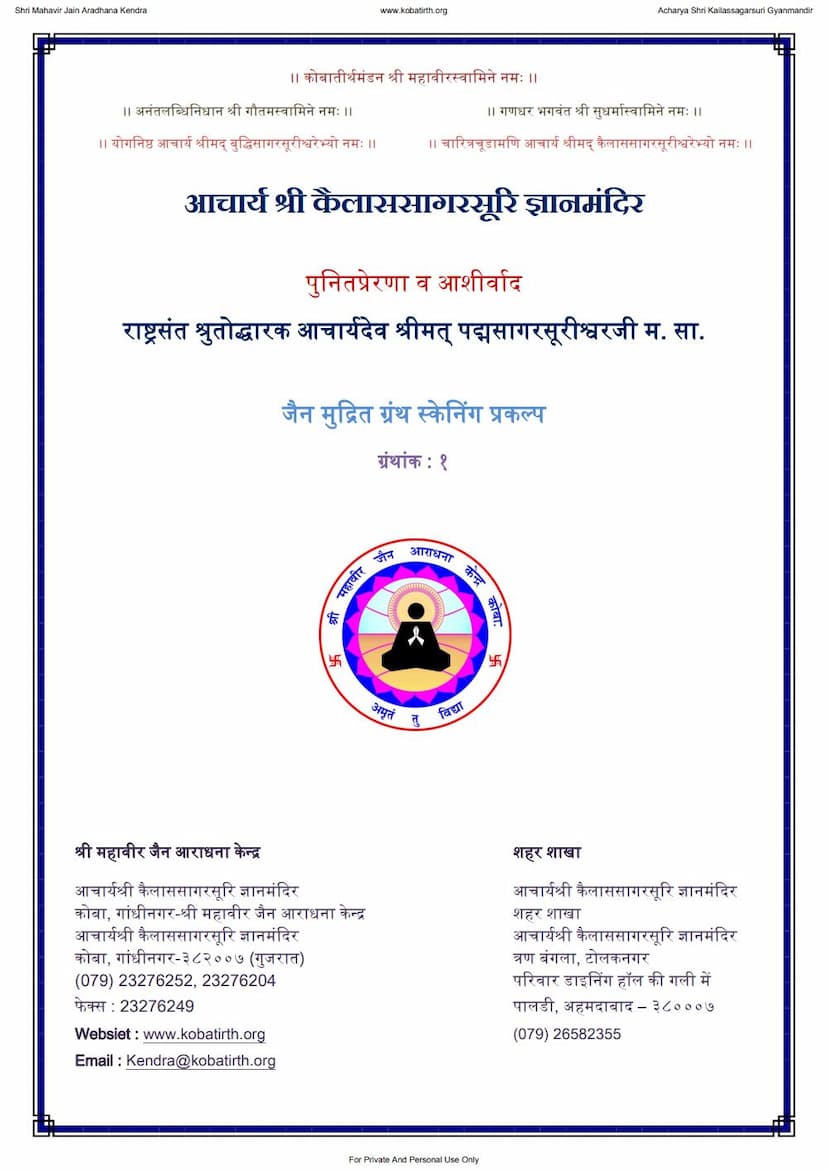Sanghpattak
Added to library: September 2, 2025

Summary
The text you provided is a substantial portion of the Jain scripture Sanghpattak, authored by Acharya Jinavallabhsuri, with a commentary (Laghuvritti) by Harshraj Upadhyay. The publisher is Jinduttsuri Gyanbhandar.
Here's a comprehensive summary in English, drawing from the provided pages:
Title: Sanghpattak (Also transliterated as Sanghapattak or Sankpattak)
Author: Acharya Jinavallabhsuri (Virachit)
Commentary (Laghuvritti): Harshraj Upadhyay (Vihit)
Publisher: Jinduttsuri Gyanbhandar
Context and Significance:
The Sanghpattak is a significant work in Jain literature, particularly within the Kharatara Gaccha tradition. It's described as a short, impactful poetic text (40 verses) that serves as a "treatise on the rules of the monastic community" or a "code for the Sangha." Its core purpose is to highlight and critique the deviations from true Jain conduct prevalent in the era, particularly the practices of Chaityavasins (monastics residing in temples and living luxurious lives, detached from true spiritual practice) and to advocate for the Suvihit path (the path of righteous conduct).
Historical Background:
- Author's Time: Acharya Jinavallabhsuri lived around the 12th century (V.S. 1125-1167). The text was revised by him in V.S. 1125.
- Problem Addressed: The text arose during a period when some monastic orders (Chaityavasins) were prioritizing worldly knowledge and practices over the strict adherence to the spiritual discipline prescribed by Lord Mahavir. These Chaityavasins were criticized for living like wealthy abbots, enjoying opulent lifestyles, and neglecting the core tenets of Jainism.
- Lineage: Jinavallabhsuri was a disciple of Acharya Jinneshvara Suri and later received initiation (upasampada) from Acharya Abhayadevasuri, a prominent figure of the Suvihit (Kharatara) sect. This establishes his adherence to the orthodox Jain path.
- Purpose of Sanghpattak: The Sanghpattak was inscribed on a stone slab at the main entrance of a newly constructed temple in Chittorgarh, which was built under the influence of Jinavallabhsuri. It was intended as a guide for the monastic community.
- Commentaries: The work's importance is underscored by the numerous commentaries written on it over centuries, including the "Brihadvritti" by Acharya Jinpatisuri and the "Avchuri" by Sadhukirti Gani, indicating its profound scholarly attention.
Core Themes and Content:
The Sanghpattak, through its 40 verses, meticulously analyzes and criticizes ten specific areas of deviation from the righteous path, which are considered "doors" leading to spiritual downfall. These critiques are presented in a poetic and often allegorical manner. The main themes revolve around:
- Critique of Chaityavasins and Deviation from Conduct: The central theme is the exposure of the laxity and wrongdoings of those who presented themselves as monks but indulged in worldly pleasures and neglected their spiritual duties.
- The Ten Deviations (Dwaras): The text systematically outlines ten key areas where individuals strayed from the path:
- Audeshika Bhojan (Aadhamik Food): The consumption of food prepared with impure intentions or in ways forbidden by scriptures, often for the sake of pleasing the Sangha or for personal indulgence.
- Jingruh Vas (Temple Residence): Improper residence in temples, often marked by worldly activities like music, dance, and associating with impure company, instead of adhering to monastic seclusion.
- Vasatyakshama (Hostility towards Monasteries): Dislike or envy towards legitimate monastic residences (upasrayas).
- Dhan Swikar (Acceptance of Wealth): The acceptance of wealth and possessions, which is contrary to monastic vows.
- Griha Shradh Swikar (Acceptance of Householders): The improper acceptance of householders and their affairs.
- Chaitya Swikar (Acceptance of Temples): Claiming ownership or undue attachment to temples.
- Aprekshita Asana (Uninspected Seat): Using seats (like Gaddi, Masoorak, etc.) that are not properly inspected for hidden life forms, leading to inadvertent violence.
- Savadhya Acharit Adar (Adherence to Sinful Conduct): Taking pride in and practicing sinful actions.
- Shruta Path Avajna (Disregard for Scriptures): Disrespecting or ignoring the scriptural teachings and the wisdom of learned monks.
- Guni Dwesh Dhi (Enmity towards Virtuous Ones): Hatred and malice towards genuinely virtuous monks and scholars.
- Emphasis on the Suvihit Path: The text implicitly and explicitly champions the path of righteousness, adherence to scriptural discipline, and the conduct of virtuous monks.
- The Role of Karma and Ignorance: The text highlights how ignorance (avidya) and the accumulation of karma, fueled by worldly desires and attachment, lead individuals astray.
- The Importance of a True Guru: It implicitly stresses the need for a genuine spiritual guide who adheres to scripture and leads followers towards liberation.
- Social Critique: The Sanghpattak serves as a social critique of the religious practices and leadership of the time, lamenting the spread of falsehood and the decline of true spiritual discipline.
Structure of the Commentary (Laghuvritti):
The pages reveal a detailed verse-by-verse explanation of the Sanghpattak, along with extensive references to Jain scriptures and philosophical concepts. The commentary also engages in historical and textual analysis, discussing the authenticity of manuscripts and the lineage of scholars.
Key Arguments and Examples:
- The commentary often uses analogies and logical reasoning to demonstrate the fallacy of the Chaityavasins' arguments and practices.
- It draws parallels between the flawed conduct of some contemporary monks and the ascetic practices of figures like Kamathamuni, whose penance was ultimately deemed flawed.
- The text also addresses the concept of "Gaccha-bandh" (attachment to one's own monastic lineage), which can blind individuals to the truth and lead them to defend even incorrect practices.
Overall Message:
The Sanghpattak, through its profound poetic critique and the detailed commentary, serves as a timeless reminder of the importance of adhering to the true principles of Jainism, the dangers of worldly attachments and corrupt spiritual leadership, and the necessity of seeking genuine knowledge and virtuous conduct for spiritual liberation. It's a call for introspection and a reaffirmation of the scriptural path.